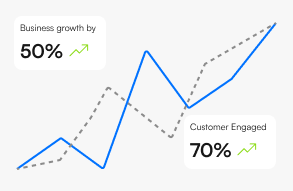Maximizing Business Potential: Uncovering the Benefits of Conversational AI

Namrata Chakraborty
April 05, 2024
6 min

Table of Contents
In the rapidly evolving landscape of technology, Conversational AI has emerged as a game-changer, offering a plethora of benefits that redefine how businesses interact with customers and streamline their operations. This innovative technology, powered by natural language processing and machine learning, enables seamless communication between humans and machines, revolutionizing customer service, internal processes, and decision-making. As businesses strive to stay ahead in a digitally-driven world, understanding the myriad advantages of Conversational AI becomes paramount.
Moreover, with the accessibility of ai chatbot makers, creating a chatbot is easier than ever before, democratizing the process and making Conversational AI widely beneficial for society. This accessibility empowers businesses of all sizes and industries to enhance customer experiences and optimize efficiency.
6 Unmissable Benefits of Conversational AI
The following are some of the most important advantages of AI-powered chatbots and conversational tools for any business:
1. Scalability and Cost Efficiency
Conversational AI chatbots are capable of managing multiple conversations simultaneously through parallel processing and automation. Unlike human agents who can only handle one conversation at a time, chatbots can engage with numerous customers concurrently without compromising response times or service quality.
One of the benefits of these chatbots is that these are equipped with advanced algorithms that prioritize and organize incoming messages based on factors such as urgency, context, and customer history. They can understand and respond to inquiries autonomously, retrieving information from databases or knowledge bases as needed.
During the COVID-19 pandemic, numerous organizations and governments worldwide deployed chatbots to manage the crisis effectively. The World Health Organization (WHO) expanded its WHO Health Alert platform to Facebook Messenger, offering instant and accurate COVID-19 information globally. Accessible in English, French, Spanish, and Arabic through the WHO’s official Facebook page or Messenger link, this interactive service reached over 12 million people via WhatsApp.
2. Reduced Wait Time in Customer Support
A Zendesk studyfound that First Reply Time (FRT) or average response time significantly impacts customer satisfaction. The availability of chatbots round the clock and their ability to manage numerous conversations simultaneously give them a distinct advantage in surpassing human limitations.
Let’s take the example of Amazon Chat. Amazon Chat enables customers to engage in text-based conversations with AI-powered chatbots on the Amazon website or mobile app. These chatbots handle common inquiries, such as order status updates, return requests, and product information. Through automated responses and guided workflows, they provide efficient assistance, reducing the need for customers to wait for human support.
If a customer’s query requires human intervention or exceeds the capabilities of the virtual assistant or chatbots, Amazon seamlessly transfers the conversation to a live customer service representative. This ensures that customers receive personalized assistance and resolution for complex issues.
3. Multichannel Integration
Conversational AI serves as the linchpin for businesses aiming to provide unparalleled customer engagement. By seamlessly integrating across a myriad of communication channels— ranging from websites and mobile apps to social media platforms and messaging apps— Conversational AI empowers customers to interact with businesses effortlessly.
For instance, imagine a customer who initiates a support inquiry via a messaging app but later prefers to switch to email for a more detailed conversation. With Conversational AI seamlessly integrated across channels, this transition is smooth and uninterrupted, allowing the customer to receive consistent and personalized assistance regardless of the platform they choose.
In such cases, the Conversational AI system recognizes the customer’s identity and query history, ensuring continuity in the conversation and preserving context as the interaction moves to a different channel.
4. Improved Employee Productivity
Beyond customer-facing applications, Conversational AI can also streamline internal processes and enhance employee productivity. In HR, it streamlines processes like onboarding, leave management, and policy inquiries, replacing manual paperwork with efficient chatbot interactions. Additionally, these AI-driven solutions can automate mundane tasks like setting reminders for deadlines and scheduling meetings, allowing employees to focus on high-value tasks.
5. Data-driven decision
In today’s rapidly evolving business landscape, data stands as the cornerstone of informed decision-making, driving innovation, efficiency, and competitiveness. At an individual level, data has become equally pivotal, shaping personal experiences, preferences, and behaviors, guiding choices in various aspects of life. One of the key benefits of conversational AI include its ability to process a large variety of data and make sense of it, facilitated through chatbot analytics.
Take for example, Cleo, a personal finance chatbot accessible on platforms like Facebook Messenger and Slack. Cleo aids users in financial management by offering insights into spending habits, setting budgets, tracking expenses, and providing financial advice. Users engage with Cleo using natural language, posing questions or commands regarding their finances. Cleo analyzes users’ financial data, including transaction histories from linked accounts, using machine learning algorithms to generate personalized insights and recommendations.
For instance, if Cleo detects excessive spending on dining out, it may suggest setting a restaurant budget or cooking at home to save money. Proactive alerts are sent if users approach budget limits, fostering financial responsibility.
6. Strict Security & Compliance
Conversational AI platforms play a critical role in safeguarding customer data through adherence to stringent data protection regulations and chatbot security protocols. For example, consider a banking institution implementing an AI-powered chatbot to assist customers with account inquiries and transactions. In this scenario, the chatbot is programmed to handle sensitive financial information securely, ensuring that customer data remains confidential and protected from unauthorized access.
To illustrate, when a customer interacts with the chatbot to check their account balance or transfer funds, the Conversational AI platform encrypts the data exchange between the customer’s device and the bank’s servers using advanced encryption algorithms. This encryption ensures that sensitive information, such as account numbers and transaction details, remains secure and inaccessible to malicious actors.
Conversational AI platforms often undergo rigorous security assessments and adhere to industry-standard security frameworks, such as ISO 27001, to ensure compliance with data protection regulations like GDPR and CCPA. These platforms implement measures such as multi-factor authentication, access controls, and regular security audits to mitigate the risk of data breaches and maintain compliance with regulatory requirements.
Wrapping it up
Looking ahead, the future of conversational AI holds immense promise and potential for further evolution and innovation. As advancements in natural language processing, machine learning, and deep learning continue to unfold, conversational AI will become increasingly sophisticated, capable of understanding context, tone, and intent with greater accuracy and nuance. This will enable chatbots and virtual assistants to deliver more personalized and human-like interactions, fostering deeper engagement and satisfaction among users.
The future of conversational AI holds immense promise for enhancing human-machine interactions, driving innovation, and transforming industries. As these technologies continue to evolve and mature, they have the potential to revolutionize the way we live, work, and interact with the world around us.

Grow Your Business with AI Agents
- Automate tasks
- Engage customers 24/7
- Boost conversions